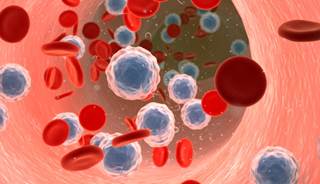
Diagnosed with SMM, SPB, or MGUS?
Learn how you can stall the development of full-blown Multiple Myeloma with evidence-based nutritional and supplementation therapies.
Click the orange button to the right to learn more.
- You are here:
- Home »
- Blog »
- Pre-Myeloma »
- Living with MGUS
Living with MGUS

“…enabled detection of MGUS in 5.1% of the members of the community tested in the Olmsted County screening study cohort in the age group of 50 years or older.”
According to the research linked and excerpted below, there are more than 117 million Americans 50 and older — 35 percent of the total population in the United States. Just over 5% of those 117 million people are living with MGUS.
That means that almost six million people in the United States are living with MGUS. These people are walking around with MGUS aka a plasma cell dyscrasia and are none the wiser.
That’s a lot of MGUS. The amazing thing, to me anyway, is that most of those 6 million folks have no idea that they have a blood disorder.
- Most of those people will never know that they have MGUS
- About 30,000 of those who have MGUS will be diagnosed with MM someday
But the two most important issues for the newly diagnosed MGUS patient are highlighted in the bottom article linked below. Those two key issues are:
- Conventional oncology fails to recognize evidence-based, non-conventional, non-toxic therapies shown to reduce the risk of a full-blown MM diagnosis and
- Conventional oncology has begun promoting chemotherapy to treat pre-MM. The benefit of which, according to Dr. Ola Lundgren, is a “deep, sustained treatment response.” Dr. Lundren does not mention that no clinical study of pre-MM treatment has shown longer overall survival (OS). Also, Dr. Lungren does not mention possible short, long-term and late stage side effects that accompany chemotherapy.
If you have MGUS would want to know it? If you’re reading this blog post about MGUS then you’ve probably been diagnosed with pre-MM- either SBP, MGUS or SMM.
If you had MGUS and could take steps to reduce your risk of MM (and other chronic diseases) then would you want to learn about them?
The Pre-MM CC Course illustrates:
- the diagnostic testing for both pre-mm and full MM
- diagnostic tests that indicate the risk of MM
- nutrition shown to reduce the risk of full MM
- supplementation shown to reduce the risk of MM
- lifestyle therapies shown to reduce the risk of MM
- learn about your SBP, MGUS and SMM symptoms such as bone or nerve pain and possible Deep Vein Thrombosis.
- To Learn More about Monoclonal Gammopathy of Undetermined Significance (MGUS)- click now
- To Learn About Pre-Myeloma (SPB, MGUS, MGCS, SMM), diagnostics, symptoms and therapies- click now
Scroll down the page and post a question or a comment. I will reply to you ASAP.
Thank you,
David Emerson
- MM Survivor
- MM Cancer Coach
- Director PeopleBeatingCancer
Recommended Reading:
- Multiple Myeloma Diagnosis- Can’t Trust Conventional Cancer Research
- Diagnostic Testing for MGUS
- Single Plasmacytoma, MGUS or SMM? To treat or watchful waiting?
Mass Spectrometry for Detection of Monoclonal Gammopathy of Undetermined Significance
“A research team evaluated mass spectrometry-based methods of detection for monoclonal gammopathy of undetermined significance (MGUS)and, using monoclonal immunoglobulin rapid accurate mass measurement (miRAMM), estimated that MGUS was present in 5.1% of individuals aged 50 years or older in a screening cohort…
From baseline samples, the researchers reported that immunofixation showed a monoclonal protein present in 10.6% of patients, compared with rates of 50% by MALDI-TOF and 65.9% by miRAMM. The miRAMM technique was also able to detect oligoclonal to monoclonal transitions.
The miRAMM approach enabled detection of MGUS in 5.1% of the members of the community tested in the Olmsted County screening study cohort in the age group of 50 years or older.
“The primary purpose of this study was to explore the epidemiology of MGUS using a more sensitive method,” wrote the researchers. “We found that a monoclonal protein can be detected by mass spectrometry (MALDI-TOF or miRAMM) in most patients several years prior to the diagnosis of clinical MGUS.”
The researchers concluded that MALDI-TOF is easier to perform than miRAMM is and that miRAMM is more sensitive but requires more resources. They noted that currently, miRAMM is used primarily for research purposes and suggested that it could be useful for measurable residual disease analysis.”
Demographics of an Aging America
“Today, just over 34 percent of the US population is aged 50 and over, and their numbers are rising rapidly with the aging of the baby-boom generation…
Over the next two decades, more than 27.7 million people will join the 50-and- over age group. Most of the increase, however, will be among the population aged 65 and over, projected to surge by 65 percent by 2030…
Demographics of the United States
“The United States is the third-most populous country in the world, with an estimated population of 330,746,845 as of December 25, 2020.[10] …
MGUS to Myeloma: Study Suggests Risk of Progression Can Change
“A new study suggests that a person’s risk of progressing from a benign condition called monoclonal gammopathy of undetermined significance (MGUS) to multiple myeloma, a type of blood cancer, can change over time…
But according to the new findings, published July 18 in JAMA Oncology, the levels of those blood markers—and the risk of developing cancer—can change over time…
So, if you’re only going to do one test to determine risk, it’s probably not accurate,” he added…
Further studies are needed to confirm these results, wrote Nikhil Munshi, M.D., of Dana-Farber Cancer Institute, and his colleagues in an accompanying editorialExit Disclaimer. But if confirmed, the results “would require rethinking” how people with MGUS are cared for, they wrote…
There is no treatment to prevent MGUS from progressing into multiple myeloma. Follow-up care for those with MGUS depends on a person’s initial risk assessment…
Among those who developed multiple myeloma and had at least three serial blood samples available, 70% had a low- or intermediate-risk score in earlier blood samples prior to a high-risk score in subsequent samples. This pattern “shows a slow but continuous progression” toward multiple myeloma, Dr. Munshi and his colleagues explained.
But a few of the people who developed multiple myeloma had low- or intermediate-risk scores just 1 year before their cancer diagnosis. One potential explanation is that the abnormal plasma cells of these individuals acquired new genetic changes that led “to more abrupt progression,” the editorialists wrote…
Another benefit of early detection is earlier treatment with “new, highly efficacious drugs which can translate into deep, sustained treatment responses,” Dr. Landgren said, including those that are negative for minimal residual disease…”


